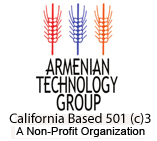
The Armenian Technology Group (ATG) began planting more than thirty varieties of American winter and spring wheat on trial plots in Armenia in 1992. Thanks to a $1.65 million grant from the U.S. Agency for International Development, ATG’s involvement was greatly expanded in 1994.
What became known as the wheat seed project was designed primarily as a humanitarian relief effort. Although the Armenian republic in 1994 was slowly regaining its bearings, conditions remained dire. At least half the country’s farmland lay fallow, often because farmers lacked seeds. Nearly 80 percent of Armenia’s wheat was donated by the United States and the European Union.
Through ATG’s efforts, nearly 5,000 metric tons of American and Russian wheat seed were supplied to more than 6,000 Armenian farmers in 1994. Nearly 42,000 acres of winter wheat were sown in the fall. Fertilizer and herbicide were provided for almost one-third of the fields.
In addition, ATG introduced an extensive program of technical assistance. Five American technical advisers conducted workshops in Armenia to train 33 local agronomists. The agronomists in turn reached 6,500 farmers.
Doubt turns to trust
For Hovik Saribekian, ATG’s assistance was the difference between an abundant crop and another lean year. Like many of his neighbors, Saribekian was initially doubtful of ATG’s project. Few in his region expected the American varieties to be suited to Armenia’s climate and soil. Saribekian, however, was willing to take a chance. Most of his land had gone untilled in 1993 because of the shortage of basic inputs. A visit to a nearby village convinced him of the potential of the American varieties.
Saribekian planted Eltan, a variety cultivated in the American Northwest, on a 62-acre plot he and his neighbors worked in partnership. Saribekian also participated in a series of ATG workshops that focused on seedbed preparation, planting techniques, and the application of fertilizer and herbicide. The harvest brought in 1.6 metric tons of wheat per acre — double Saribekian’s typical yield. Eltan became known around Hrazdan as “American gold.”
“The proof was in the results,” Saribekian said. “In 1995, almost all of the local farmers felt obliged to plant the American varieties.”
By the fall of 1996, the wheat seed project had begun to sink homegrown roots. About one-third of the wheat seed being sown in Armenia was generated through ATG’s efforts. Yields averaged nearly three times higher than those from local varieties. In many regions, the American varieties displaced Bezostaya, the standard of the Soviet era. In the northern region of Tumanian, for example, local farmers took their original allotment of American seed and increased it sixfold. Andranik Asatrian, a neighbor of Saribekian from the village of Solak, was so impressed by Eltan that he launched a private enterprise to produce the seed commercially.
New techniques boost harvests

The wheat seed project has left a lasting impact on other aspects of Armenian agriculture as well. Farmers who participated in the ATG trial have reduced the amount of seed they plant per acre by nearly 60 percent, without sacrificing yields. According to Razmik Mnatsakanian, a farmer from the village of Kaghsi near Hrazdan, ATG played a pivotal role in producing a wheat harvest that was nearly twice as large as the previous year. Mnatsakanian attributes much of the increase to more effective use of fertilizers and herbicides — expertise gained through ATG’s technical assistance program. A shift in attitudes has also occurred, Mnatsakanian believes.
“Farmers today are motivated to make use of the latest technology and collaborate with ATG,” he said.
In the Lori District, agronomist and farmer Slavik Anakhasian reports a similar awakening. Under Soviet rule, Anakhasian explains, innovation and experimentation were discouraged. Once ATG’s technical advisers gained the confidence of local farmers, most were ready to embrace new planting techniques.
“After farmers saw the results of what they had learned in the workshops, they understood that ATG’s approach to seedbed preparation made sense,” he said.
ATG’s wheat seed project has shaped how ATG’s specialists think about their organization’s future role.
Thinking long term
Gagik Mkrtchian, a local ATG agronomist and the coordinator of the wheat seed project, recognizes that, like Armenia as a whole, ATG must shift from addressing immediate humanitarian concerns to tackling long-term economic development issues.
Mkrtchian’s chief priority is improving yields, especially for wheat. By his calculations, Armenia is capable of producing 540,000 metric tons of wheat annually on 445,000 acres by boosting average yields to about 1.2 metric tons per acre. (In normal circumstances, Mkrtchian explained, Armenia should consume about 1.2 million metric tons of grain — 700,000 for human use and 500,000 for animal feed.) Devoting more acreage to wheat, Mkrtchian says, would skew the country’s agricultural balance away from high-value specialty crops, such as tree fruit.
Mkrtchian looks forward to a closer partnership with Armenia’s government to rebuild the scientific and technological infrastructure of the republic’s agricultural system.
As a by-product of the wheat seed project, ATG has cultivated a network of trained regional extension specialists, as well as a reputation for competence and trustworthiness among farmers. Mkrtchian would like ATG, in cooperation with Armenia’s Ministry of Food and Agriculture, to educate more farmers about the latest techniques in seedbed preparation and the application of inputs.
Mkrtchian also envisions a role for ATG in creating a nationwide seed bank. The current stage of ATG’s wheat seed project is geared toward rejuvenating Armenia’s seed stock and bolstering research on new seed varieties. ATG’s plans call for the establishment of a seed producers association, as well as new agencies devoted to verifying and improving seed quality. Ultimately, ATG hopes that the wheat multiplication project will serve as a spawning ground for start-up agrobusiness companies.

Follow Us